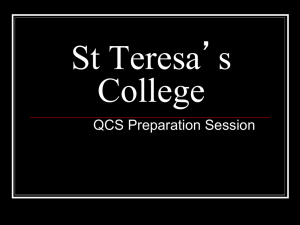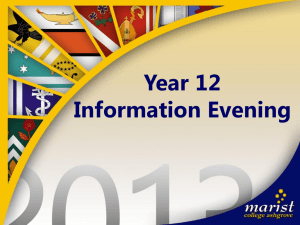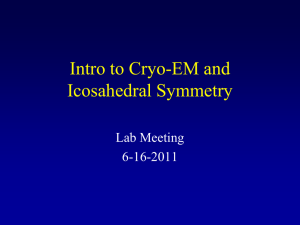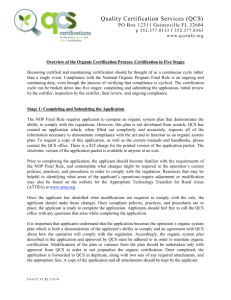The end of the beginning
advertisement
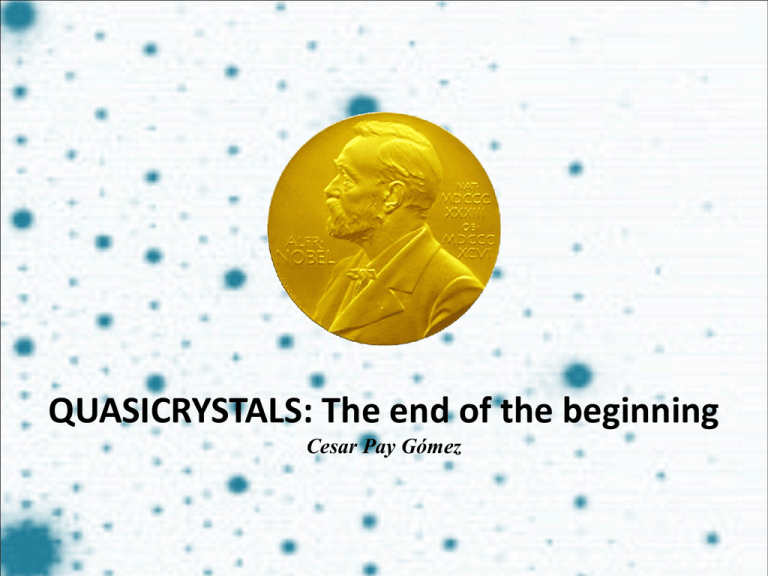
QUASICRYSTALS: The end of the beginning Cesar Pay Gómez Outline • History of Quasicrystals • “Where are the atoms?” • Past, present and future Dan Shechtman The Nobel Prize in Chemistry 2011 is awarded to Dan Shechtman for the discovery of quasicrystals. Crystal Before QCs A homogenous solid formed by a repeating, three-dimensional pattern of atoms, ions, or molecules and having fixed distances between constituent parts. Crystal Electrons X-rays Glass ? 2-, 3-, 4-, 6-fold A A' B B' 5 fold symmetry unit ? 5-fold symmetry! Non-periodic! Shechtman et al. Phys. Rev. Lett., 53, 1951 (1984) The discovery Crystal Before QCs A homogenous solid formed by a repeating, three-dimensional pattern of atoms, ions, or molecules and having fixed distances between constituent parts. After QCs Any solid having an essentially discrete diffraction diagram. The word essentially means that most of the intensity of the diffraction is concentrated in relatively sharp Bragg peaks, besides the always present diffuse scattering. By 'aperiodic crystal' we mean any crystal in which three-dimensional lattice periodicity can be considered to be absent. Quasicrystals • • • • • Long-range ordered, aperiodic crystals with sharp diffraction peaks. Exhibit crystallographically forbidden symmetries (such as 5-, 8-, 10- or 12-fold rotational symmetry) Lack periodicity (no unit cell) in 3 dimensions. The diffraction patterns cannot be indexed with 3 integers (6 are needed for icosahedral QCs). The structures can be described as projections from a high dimensional space. Al-Cu-Fe: Stable, ~cm Quasicrystals • • • • • Long-range ordered, aperiodic crystals with sharp diffraction peaks. Exhibit crystallographically forbidden symmetries (such as 5-, 8-, 10- or 12-fold rotational symmetry) Lack periodicity (no unit cell) in 3 dimensions. The diffraction patterns cannot be indexed with 3 integers (6 are needed for icosahedral QCs). The structures can be described as projections from a high dimensional space. Penrose pattern C B 36゜ D A AC AB = τ = CD AC 1 τ 1+τ τ=(1+√5)/2 ~1.618 C 72゜ B A D τ=(1+√5)/2 ~1.618 τ+1= τ2 5-fold symmetry Non-periodic! Shechtman et al. Phys. Rev. Lett., 53, 1951 (1984) τ-1=1/τ 5-fold symmetry Non-periodic Self-similarity (irrational) Quasicrystals • • • • • Long-range ordered, aperiodic crystals with sharp diffraction peaks. Exhibit crystallographically forbidden symmetries (such as 5-, 8-, 10- or 12-fold rotational symmetry) Lack periodicity (no unit cell) in 3 dimensions. The diffraction patterns cannot be indexed with 3 integers (6 are needed for icosahedral QCs). The structures can be described as projections from a high dimensional space. Dihedral Quasicrystals 1 τ 1+τ τ=(1+√5)/2 ~1.618 5-fold symmetry Non-periodic! Shechtman et al. Phys. Rev. Lett., 53, 1951 (1984) 4Å 4Å Periodic direction Quasicrystals • • • • • Long-range ordered, aperiodic crystals with sharp diffraction peaks. Exhibit crystallographically forbidden symmetries (such as 5-, 8-, 10- or 12-fold rotational symmetry) Lack periodicity (no unit cell) in 3 dimensions. The diffraction patterns cannot be indexed with 3 integers (6 are needed for icosahedral QCs). The structures can be described as projections from a high dimensional space. 63.43° 1 τ 116.57° 1+τ τ=(1+√5)/2 ~1.618 5-fold symmetry Non-periodic! Shechtman et al. Phys. Rev. Lett., 53, 1951 (1984) 3D Space filling by two rhombohedra Icosahedral Quasicrystals Quenched Al-Mn alloy Icosahedron Shechtman et al. Phys. Rev. Lett., 53, 1951 (1984) QC families Bergman cluster (Frank-Kasper type) Mackay cluster Tsai cluster (Yb-Cd type) Approximants • • • Conventional crystals with periodic long-range order and 3D unit cells. Should have similar compositions and local atomic arrangements (clusters) as the quasicrystals. The structures can be solved by standard diffraction techiques. 1/1 approximant YbCd6 2/1 approximant Yb13Cd76 ”Where are the atoms?” Structure of i-YbCd5.7 QC H. Takakura, C. Pay Gómez, A. Yamamoto, M. de Boissieu, A. P. Tsai, Nature Materials. 2007, 6, 58 Building blocks and linkages in Yb-Cd type approximants 1/1 approximant YbCd6 2/1 approximant Yb13Cd76 b c subshells Yb-Cd type Atomic cluster H. Takakura*, C. Pay Gómez, A. Yamamoto, M. de Boissieu, A. P. Tsai Nature Materials. 2007, 6, 58 C. Pay Gómez*, S. Lidin Angew. Chem., Int. Ed. Engl. 2001, 40, 4037 Tsai i-YbCd5.7 Bergman (FK-type) C. Pay Gómez*, S. Lidin Angew. Chem., Int. Ed. Engl. 2001, 40, 4037 Qisheng Lin, John D. Corbett*, Proc. Nat. Acad. Sci. 2006, 103, 13589 QC families Bergman cluster (Frank-Kasper type) Mackay cluster Tsai cluster (Yb-Cd) Conclusions • Due to the discovery of QCs, the definition of crystal had to be changed. • QCs have long-range order but lack periodicity in 3D space. • Approximants are ”normal” crystals containing the same atomic clusters as QCs. • Icosahedral QCs can be described as periodic structures in 6D space. Thank you!


